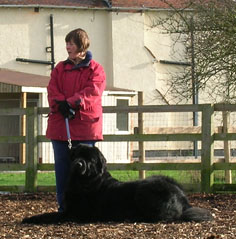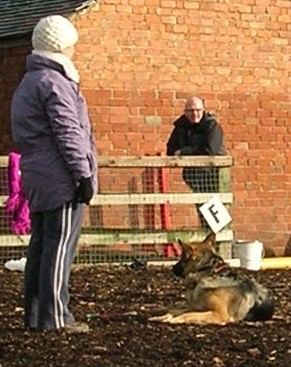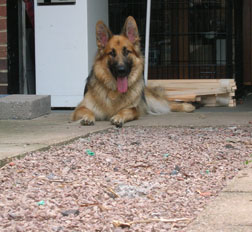
The Down Position - When you start to train your puppy or an older dog, enrol with a Dog Training Club, where your progress can be monitored and problems stopped before they become mountains!
Teaching the "Down"
This method of teaching Down is simple and rewarding for you and your dog. Make sure you are on your own with no distractions. Start with your puppy from 6 weeks onwards. The best way is with treats - incorporate the 'come' and 'sit' with this exercise. The reason for this is because the dog will be relaxed and already eager to please as you have already rewarded him (with treats and fuss).
Call your dog - reward him, then sit him - reward him. Then show the dog his treat and slowly move your hand down to the floor. Gently press on the dogs' shoulders to encourage him to follow the treat into the down position. Reward him, stroke him commanding soothingly 'Down', keep repeating the command to a count of five, finish and reward.
Keep your voice calm and once he is down, stay with him and sooth him. Your dog will soon learn that there is pleasure with this position. With young energetic dogs, tickle their tummy! This can relax them.
Do not stand up to start with, as this can be a signal to move with you. Then you have to start all over again. Keep the dog down to a count of five and release.
When the dog is laying quite happily on command, then start to stand very slowly. If the dog follows you up, slowly push him back down.
Start to use the 'down' command as often as you use 'sit'. Start to alter your commands - sometimes when you call your dog, make his first position 'down'. This brings variety into your training.
For some unknown reason, handlers can become very loud and threatening, sometimes bellowing in the dog's ears. This frightens the poor thing and all it wants to do is run! The handler gets louder - the dog starts to resist. Then a battle of strength begins. Determined looks on both faces, who will win?
Then the wrestling match begins. Legs being pulled all over the place, tails being grabbed, the handler ending up lying on top of his dog! A triumphant look on the dogs face. (Oh, HAPPY DAYS!) For some dogs, this position can be very stressful. Some dogs will fight and resist you, some dogs will growl and complain and will bare their teeth. If this happens, you must seek advice. A training school or some other qualified professional. I stress QUALIFIED.

